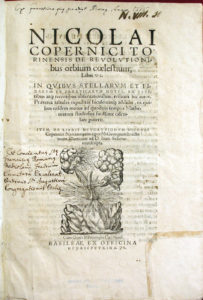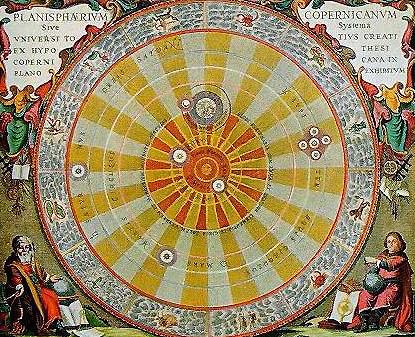
The Earth-centered universe was the prevailing wisdom of Medieval Europe until a Polish scholar named Nicolaus Copernicus suggested otherwise in his 1543 book, On the Revolutions of Celestial Spheres. Copernicus was not the first person to suggest a heliocentric model of the universe; 1800 years prior Aristarkhos of Samos suggested this same idea. However that idea never took hold among most scholars and was never able to compete with the geocentric model championed by Ptolemy and laid out in his popular treatise known as the Algamest. The Algamest was to become the dominate cosmology of Europe for over a millennia.
The 16th century marked a turning point in history where long held beliefs about the universe first seriously began to be questioned. The discovery of the new world at the end of the prior century no doubt had an impact on people questioning the ancient and authoritative accepted wisdom of the time. If the Earth wasn’t like people thought it was, maybe the celestial sphere above us wasn’t either?
A Radical Astronomical Idea Ahead of it’s Time
The fact of the heliocentric solar systems seems common knowledge to everyone today but we must remember the technological limitations of the period in which this writing took place. Prior to the invention of the telescope astronomers had to rely on naked eye observations. This method was very imprecise and led many to believe that the sun, moon, and stars revolved around the earth. It took the unique imagination and creative mind of Copernicus to suggest a different model of the solar system.
Copernicus was a student of history. He studied many previous works of astronomy and he even mastered the Greek language to read parts of Ptolemy in Greek. In 1514 he had written a brief outline of his work devoid of any mathematics which he showed to a few close acquaintances. In the proceeding years he continued to gather additional data to support his theory. He did not publish his work for nearly 30 years until two friends encouraged him to finally publish it. His delay in publishing was due to his well founded fears that his work would create a controversy within the Catholic Church.
This treatise itself is divided into six sections, closely mirroring Ptolemy’s Algamest. Copernicus made his heliocentric argument from a mathematical perspective rather than as a physical truth. Some of his immediate predecessors such as Tycho Brahe seems to agree. Brahe stated that he believed in the mathematical superiority of the Copernicus model however he doubted its physical truth in reality. Copernicus also relied on the conventional wisdom of the time that all heavenly bodies revolve in perfect circles and so he continued to use the epicycles, additional series of circles, also used in the Ptolemaic system.

On the Revolutions of Celestial Spheres is treatise is about astronomy, but it also impacted the philosophical view of humanity. It was a radical break from the traditional thought of the time as Copernicus indicates in the passage below.
I therefore took this opportunity and also began to consider the possibility that the Earth moved. Although it seemed an absurd opinion, nevertheless, because I knew that others before me had been granted the liberty of imagining whatever circles they wished to represent the phenomena of the stars, I thought that I likewise would readily be allowed to test whether, by assuming some motion of the Earth’s, more dependable representations than theirs could be found for the revolutions of the heavenly spheres.
Nicolaus Copernicus
A Prelude to the Scientific Revolution
The book was published in the same year of Copernicus’ death, just before he died. We know that Copernicus had refused to publish his ideas earlier due to fear of persecution from the Catholic Church, and the books dedication to Pope Paul III was in attempt to assuage the church. Sadly, this yet another tragic example of dogmatic religious belief hindering the progress of truth, knowledge and the advancement of science.
Although hindered by the church, Copernicus’ model was later confirmed by Galileo Galilei after he observed the moons revolving around Jupiter and the phases of Venus. Even then it did not become fully accepted by scholars until Isaac Newton formulated his Law of Gravity in 1687. Additionally Copernicus’ book was largely ignored by scholars and by the church in the decades after its publication. It took the church over seven decades before it issued a decree to suspend its publication.
Despite its relatively insignificant influence in the years after its publication it can be said that this now famous work is when the Scientific Revolution in Europe began. It did not spark and immediate change in thinking and the progress in scientific advancement was gradual. Many other scientists amended and improved his ideas. But it challenged people to think differently about the accepted wisdom of the day and paved the way for other scientists to publish and produce their own original work and discoveries.
Continue reading more about the exciting history of science!